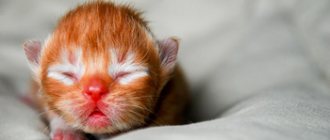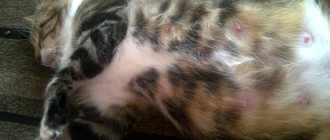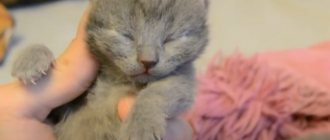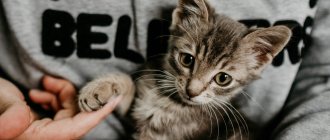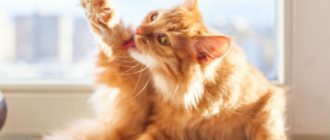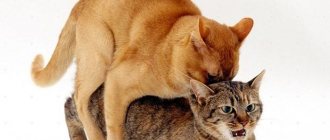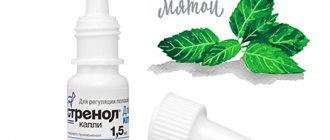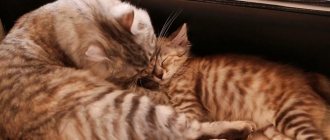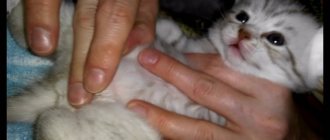If there is a new addition to your cat family, get ready for sleepless nights. And don’t even try to deceive yourself by the temporary helplessness of babies and their dependence on their mother.
Pretty soon, the fluffballs will stop crawling and confidently stand on all fours in search of adventure. At this point, you will have to answer for their safety. But knowing what time kittens begin to walk, you can protect them from possible problems, injuries and deviations.
When a baby first stands on its paws and stops crawling
Until the baby learns to walk and leave the nest, mother's milk will be the only food.
During the first week, the babies move, moving with their front paws, as if they were swimming. The eyes begin to open on the 5-7th day. Final expansion occurs by two weeks of age.
An attentive cat lover, waiting for the moment when the kittens begin to walk, observes the following stages of development of the cubs daily:
- 1-7 - blind cubs swarm around their mother;
- 8-11 - the eyes begin to open, the kittens distinguish the light, smell the mother from a distance;
- 12-15 - first attempts to rise on their paws;
- 16-20 - the cat makes its first timid movements, constantly stumbles and staggers;
Three-week-old cubs can already walk, but some babies are delayed in development. This is due to their condition at birth and the quality of mothers’ nutrition.
Until the cub learns to walk and leave the nest, mother's milk will be the only food.
How does a cat's locomotor system develop?
The musculoskeletal system consists of bones, muscles and joints. Only the hind legs are a direct continuation of the cat's skeleton. The forelimbs do not have a solid joint. They are connected to the skeleton by elastic and strong tendons. They provide smooth landings from great heights and a silent gait.
The hind legs are always stronger than the front legs, since they have to take a much larger load. They serve as support and help push off while running and jumping.
Full development of the body takes about a year, but motor function becomes available to babies already at 1 month of life. During this time they go through the following stages:
- Moving by crawling. In the first 5 days, pets move only in the direction of their mother to eat. By day 10, they begin to use their front legs. Pushing off the floor with them, the kittens ride more and more confidently on their bellies, like swimmers.
- Standing on your front paws. The first attempts are made in 1.5-2 weeks. By the end of this stage, the hind limbs also become stronger, expanding the available capabilities.
- First steps on 4 paws. When making their first movements, babies are guided by their mother. Repeating after her, they sway strongly and often fall out of the blue, but with each attempt they become closer to the goal.
- Gradual improvement of coordination to the level of adult animals. From the 3rd week, animals try to master not only walking, but also running and jumping. During the game, they can fight each other or hunt for their own tail.
The movements of whiskered pets at 1 month are very different from the timid attempts to learn to walk in the very first stages. By this age, small pets no longer fall over while running, actively play with each other and make confident jumps on low surfaces.
Everything about the development of cat paws, what you need to pay attention to
If the baby is 2 weeks old and its eyes have not opened, it is recommended to moisten them with strong tea.
Three-week-old babies begin to explore the surrounding area, gradually moving away from the nest. They come across a feeder, which should be full during lactation.
Conscientious owners use super-premium dry food that is suitable for kittens.
At this time, the felinologist needs to pay attention to the location of the den:
- choose a secluded place for the nest so that no one steps on the crawling baby;
- There should be no household appliances, wires, sharp or prickly objects near the resting place.
- The basket should not be placed on a hill so that the children do not fall out and hurt themselves.
Important! Children need to be taught how to handle kittens so as not to cause harm.
Possible problems and deviations
Treatment of the problem must begin immediately after its appearance. Otherwise, the pet may remain disabled.
Pain and weakness of the limbs are characteristic of the following pathologies:
- hip dysplasia, expressed in abnormal tissue development;
- liver diseases complicated by neurological disorders;
- acute intoxication;
- primary (arthritis) and secondary (trauma) dysfunctions of the musculoskeletal system;
- rickets, characterized by softening of the bones;
- malignant neoplasms.
The risk group includes Maine Coons. Due to active growth and large dimensions, 23% of representatives of this breed suffer from dysplasia. Their weight gain outpaces the development of joints, so the body simply cannot cope with the load placed on it. Also, this pathology can be inherited, and its presence must be recorded in the pedigree.
Please note that an animal suspected of being injured should not be transported. Shaking on the road can aggravate his condition, so it is better to call a doctor at home.
When their eyes open
The process of eye opening in cubs of different breeds begins on the 5-9th day of life. Delays may occur if the baby was born weakened or the mother is not fed correctly.
Be sure to read:
Sex barrier for cats: release forms, dosage, course of administration, indications and contraindications
Experienced breeders know breed differences. Beginning cat lovers should know that girls' eyes open earlier. Babies of long-haired breeds mature later than short-haired ones.
If the baby is 2 weeks old and its eyes have not opened, it is recommended to moisten them with strong tea or diluted boric acid and try to move them apart. In case of failure, contact an experienced felinologist or veterinarian.
Feeding mode
By 4-5 weeks, the kitten needs to develop a regular food intake routine. Feeding should be from 4 to 7 times a day, but these recommendations are average and can be adjusted up or down.
Recommended feeding frequency per day, depending on age:
- from 4 to 8 weeks – up to 7 times, night feeding should be avoided;
- from 8 to 12 weeks – up to 6 times;
- from 16 to 20 weeks – 5 times;
- from 5 to 9 months – 4 times;
- from 9 months to 1 year – three times a day.
A kitten over the age of 1 year should get used to eating twice a day with a mandatory 12-hour break.
Portions must meet the following sizes:
- from 4 to 6 weeks: 120 g of food per day;
- 8 weeks: from 160 to 180 g;
- from 12 weeks to 6 months: from 180 to 240 g, of which at least 40 g should be meat;
- 6-9 months: 180 g of food per day;
- from 10 months to 1 year: from 150 to 200 g.
You should at least approximately adhere to the amounts of food recommended by the veterinarian and the breeder. Overeating can cause major health problems in the future. An adult cat may develop obesity, pancreatitis, and diabetes.
The nuances of caring for a kitten
When the baby gets stronger, becomes curious, and begins to explore the world around him, he needs to be warned against trouble. All dangerous objects are removed from places where the cubs roam.
When the baby gets stronger, becomes curious, and begins to explore the world around him, he needs to be warned against troubles.
Kittens can get stuck in narrow places on furniture, secluded corners behind sofas, cabinets, get tangled in curtains, cling to the tablecloth and drop dishes on themselves.
The cat should not be pulled by the paws or kicked.
Slippery floors are especially dangerous. A child who gets angry can jump onto a smooth surface and damage a tendon or joint. Healthy cubs do not squeak when walking and do not limp. If something bad happens, your pet needs to be shown to a veterinarian.
The kitten should not be placed on a closet or sofa.
His ligamentous apparatus is underdeveloped, the bones have not formed. Instinct makes him jump off. This leads to injury. At the age of one month, babies play pranks, jump on their sisters and brothers, watch their mother, and try to imitate. By observing the cat's behavior near the feeder, babies become accustomed to eating solid food.
Six to eight week old pets are ready for independent living. At this time, the owner decides what to do with them - keep them, put them up for sale or give them to friends.
At this point, a responsible owner of kittens will vaccinate the pet against viral diseases, having previously treated it against worms and fleas.
What is harmful for a kitten to eat?
Cats do not have enzymes that digest sweets, so any sweet food should not be given to them, even if they “beg” for it. In general, adult animals will not try food that is not healthy for them; their instinct of self-preservation is strong. However, some kittens, especially those raised outdoors, were forced to eat unhealthy food before coming into your home, so they may be interested in potatoes, bones, and raw fish.
You should not give kittens: - nightshades: tomatoes, potatoes, - sea fish (it contains a lot of salt), - sweets, - bones, especially thin chicken bones (can get stuck in the esophagus), - untested raw meat (possible infection with parasites).
Expert advice
Veterinarians and experienced felinologists advise animal lovers who decide to get a kitten to do the following:
- Once pregnancy is established, the cat is switched to premium dry food or higher and is provided with sufficient food.
- At 2 weeks the baby's incisors erupt, and from three weeks the animal can chew granulated food. From this moment on, kittens are given dry food. By the age of two months, the cat's mouth will be armed with twenty-six teeth.
- For the safety of the babies, they are given a special playpen for kittens.
- The area around the cat's den is covered with carpet.
- Before the babies get stronger and begin to leave the nest, dangerous objects are removed.
Be sure to read:
How to distinguish a male kitten from a girl: a newborn, in the first days of life
If the kitten is injured, call a veterinarian. You cannot hesitate, otherwise the cub will die or become disabled. Transport to a hospital may worsen the injury. The cat is kept motionless until the doctor appears.
Juvenile period
The juvenile stage begins at approximately 11 weeks and lasts until puberty, which is four to five months. The kitten becomes hyperactive and curious. The owner’s task is to ensure his safety during this period. At the age of three months, the kitten has excellent spatial orientation, knows its name, is litter box trained and is independent of its mother. This means that this is the best time to transfer it to new owners.
The development of kittens by week ends at approximately three months. Further maturation slows down. At this time, the muscle corset is strengthened and the teeth are finally replaced. The period of puberty begins. Cats become adults at about one year of age.
Features of nutrition of a newborn kitten
For the first few weeks after birth, the baby feeds on the mother cat's milk. It contains all the nutritional elements necessary for a fragile body:
- microelements;
- antibodies that form colostral immunity, which contributes to the body’s immunity to various pathogens during breastfeeding.
The newborn baby is still weak and needs care
In the first days, the baby eats colostrum, which affects the immune system. Then it is replaced by milk. It contains antibodies that produce local immunity.
For your information! Cat milk promotes normal growth of the kitten. This feeding is the best option for a newborn pet.
Breastfeeding by a mother cat is carried out for 40-60 days from the moment the babies are born. Based on the size of the kittens, they can be breastfed for up to 6 months. But only for the first 1.5-2 months the cat provides basic nutrition.
Mom is able to feed several kittens at once
Then you need to introduce meat jars, starting with chicken, beef. From the 5th week, finely chopped chicken fillet is offered. First, the whole piece is placed in the freezer, then thawed at room temperature and covered with a little calcide. It can be found in any pharmacy, it consists of eggshells.
The kitten is also offered special professional food for babies from 1 month. has proven itself well in this regard. It produces a light mousse designed for kittens.
Drinking regime
The daily dose in drinking is calculated as follows: the weight of the animal is multiplied by 0.03. The indicator will show the required amount of liquid that the pet should drink per day. The value also includes the water present in the wet food. Usually it takes 80%.
It is best to give your baby clean, filtered water. If it is hard, smells of bleach, and rotten, then he will refuse it.
Note! Cats like the bowl to be full and wide, and their whiskers should not touch the container. Some cats love to drink from a fountain.
Some cats love to drink from a fountain.
